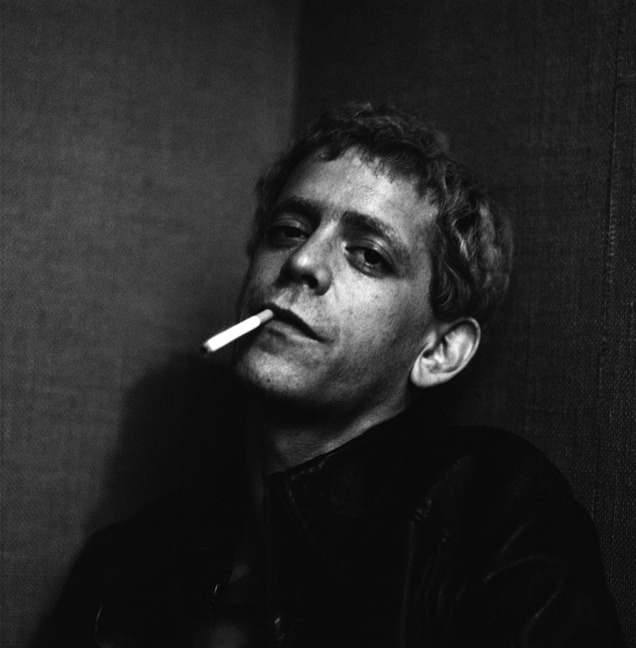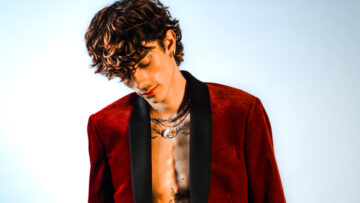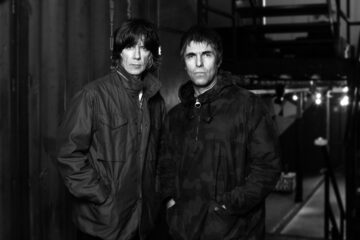
Ahead of his newest collaboration ‘MIDARO’ with artist Fin DAC, we speak to the most accomplished rock n’ roll photographer of the era. From LSD trips with Syd Barrett at Cambridge to a quadruple bypass and everything in between, Mick Rock documented musical phenomena like nobody had before.

Lou Reed Transformer Cover London 1972 © Mick Rock 2021/MIDARO/
For the 7th century monk Bede the Venerable, it was the Ecclesiastical History of the English People; for Niccolò Machiavelli, 15th century Florentine political philosophy and military affairs in The Prince; for Samuel Pepys, an extraordinary detail of London life in the 1600s. For Mick Rock, it was rock n’ roll. Widely consented to be ‘The Man Who Shot the 70s’, his mythical images chronicled perfectly the revolutionary spirit of several musical eras.
Mick’s career launched in 1972 with his portrait of an unknown David Bowie and continued to document the rise and descent of Ziggy Stardust. His career continued to soar with key 70s portraits such as Lou Reed’s Transformer, Iggy Pop’s Raw Power, Queen’s Queen II and many of the Sex Pistol’s infamous shots, joining the dots between the most fascinating and exciting characters in the world in pulse-racing, libidinous energy. Rock became one of the most sought-after photographers in the world and caught the groundbreaking New York City underground music scene pioneered by bands like The Ramones, Talking Heads, and Blondie. Now a legend himself firmly representing the era, Mick is often the number one photographer on the list of each new generation’s biggest names.
Copyright Mick Rock 2021/MIDARO
A plethora of Mick’s unseen, limited edition images have just been released, alongside Rock’s fervently anticipated collaboration with Outsider & Urban Aesthetics artist Fin DAC. The coveted artworks feature Mick’s most iconic photos manipulated and repositioned by Fin DAC into his trademark technicolour manipulations. In each of the fused artists’ works Mick’s photos beg once again for their stories to be told, tales that fans and newcomers alike never tire of hearing. Indeed, Mick’s own story is such a comprehensive account of a quintessentially rock n’ roll life that it’s indistinguishable from most the subjects’ lives he immortalised on film.
The acid in those days, I’ll tell you…
He describes his photographic awakening as an ‘explosion’, triggered by an LSD trip in 1966 when he was studying English at Cambridge University. “The acid in those days, I’ll tell you, you go and see a guy who himself is probably high on acid and he’d lay out a sheet of blotting paper and just ‘plunk!’ put a drop on it, so you never really knew how much you were gonna get.”

Life on Mars © Fin DAC/MIDARO copyright Mick Rock 2021

Heart of Glass – © Fin DAC/MIDARO copyright Mick Rock 2021

Raw Power (Japanese Edition) © Fin DAC/MIDARO copyright Mick Rock 2021

Transformer – © Fin DAC/MIDARO copyright Mick Rock 2021
It wasn’t until a couple of years later that Mick ventured his first foray into serious music photography, shooting his friend Syd Barrett’s debut solo album The Madcap Laughs, after the ex-Pink Floyd singer-songwriter left his old band. ‘People called these my classic, iconic shots. Did I know what I was up to? No. The film was all grainy and I was using a little reflector photoflood but it looked great. Everything I didn’t know about seemed to be working and producing great results. And people loved them.”

1970 The Madcap Laughs – Syd Barrett (L.P U.K 1st Harvest Records SHVL 765)
If it wasn’t for rock n’ roll Mick Rock would never have become a photographer, “I didn’t want to be a news photographer and just run around to every tragedy or some boring local event, and I certainly didn’t want to be a fashion photographer.” He was drawn in like a moth to a flame by the ability of rockstars to project themselves and to emanate outward, just like the Romantic poets he’d studied at Cambridge.
Through his affiliation with Syd Barrett Mick met the man who, in many regards, would define his career and map out his route to other icons such as Lou Reed, Iggy Pop, and Debbie Harry. ‘God bless David Bowie,’ Mick exalts breathlessly, ‘he’s raised the game to a whole other level. I caught his Greta Garbo period. Not only was he a very bizarre looking character when he was younger but he was also a beautiful man. I’ve got some images of Ziggy Stardust and if I was a screaming girl I’d be backing off and whacking off. He looks so beautiful.
A lot of people owe David, he had a certain mummy thing about him and he actually cared about people, and he showed it in his own quiet way.
‘And he bought Iggy and Lou to the table, which excited me even though they were very subterranean, and could barely give away records in those days. But David did a rescue job on them, and he did a brilliant one. A lot of people owe David, he had a certain mummy thing about him and he actually cared about people, and he showed it in his own quiet way.’ It’s difficult to surmise who owes David more for introducing them both to each other: Mick Rock or Lou Reed. Rock met Reed through Bowie whilst David was co-producing Transformer. The blurred shot of a vacantly gazing Lou Reed looks like it could have been a studio shoot, staged to make Reed look exhausted, high, spent, or anxious, but it’s actually a live photo taken at London’s King’s Cross Cinema on July 14, 1972.

Lou Reed Blonde With Cigarette London Spring 1974 © Mick Rock 2021/MIDARO

Bowie Sax BW Full Length London 1973 © Mick Rock 2021/MIDARO
‘The shot wasn’t meant for an album cover,’ says Rock, ‘but I remember showing Lou the contact sheet and he zeroed in on that. It’s actually quite a sharp shot. I went away and made a few prints, and the first pass on that one, it fell out of focus in the printing. I loved it when I saw it coming up. When I brought the prints back, Lous said, ‘That’s got to be the cover.’ And of course, it haunted him and me for about 45 years.’

Iggy Raw Power Cover BW London 1972 © Mick Rock 2021/MIDARO

Fin DAC/Mick Rock 2021/MIDARO
Mick’s stock had risen steeply as the 70s progressed, so much so that he was often more renowned than the bands who sought his magic touch, including a particularly glamorous and operatic outfit he met at Trident studios in London in September 1973. Queen were keen to test out Rock, and both parties knew his celebrity exceeded theirs at this juncture. They bonded immediately, and Mick saw in Freddie Mercury the same qualities as the other showmen he had followed: “There was something slightly otherworldly about them,” he explains, “To me they look mythological. I never saw them as inhuman, just more like fantastic creatures, chimeras in the pre-Raphaelite world. I was soaked in that stuff.
I never saw them as inhuman, just more like fantastic creatures, chimeras in the pre-Raphaelite world.
“Freddie was fascinating. You know, you wake up 30 years later, and you realise that in the purest terms he had the greatest voice to come out of rock’n’roll. I was very fond of him. We would work with those extraordinary teeth. He had an overbite caused because he had four extra teeth at the back of his mouth. He would never have them removed, though, because he felt that it expanded his palate and if they came out it might interfere with his voice. At first he would have his mouth closed, and I would let him place his lips over his teeth. Later, of course, they became something he was known for.”

Debbie Harry NYC 1978 23© Mick Rock 2021/MIDARO

Debbie Harry 21 – © Mick Rock 2021/MIDARO

Debbie Harry NYC 1978 23© Mick Rock 2021/MIDARO

Queen II, 1974, by Mick Rock
Mick became lost in the whole sequence of popular music: from art-school rockers to glam and then punk. “To me they came from the same place, they were evolutions from each other. But something happened. I got lost in the whole thing. I was torrid with chemical toxicity. One became a prisoner of one’s own image. The same thing happened with Lou and Iggy and David.” Mick had fallen victim to the same vices as the subjects he portrayed, completely caught up in the culture. Towards the tail-end of the century Mick has all but collapsed in on himself, lucky to have emerged into the 21st alive after suffering from a quadruple heart bypass.
I got lost in the whole thing. I was torrid with chemical toxicity. One became a prisoner of one’s own image.
Just as it had been there at his induction into the rock n’ roll story, luck once again looked fondly on Mick Rock, albeit this time wearied and with some new conditions. The doctor, grim but impressed, informed him if it wasn’t for his obsession with yoga and consequently fortified heart muscle (from cocaine-fuelled Vinyāsa), he’d be dead. Mastery of yoga (minus the supplemented cocaine he’d excelled with before) and healthy living followed swiftly, keeping the cogs whirring and the lens flashing, and securing Mick’s spot on the plinth of one of the country’s greatest storytellers, both visual and vocal.
- All prints will be available to purchase from the 2nd March at www.west-contemporary-editions.com




